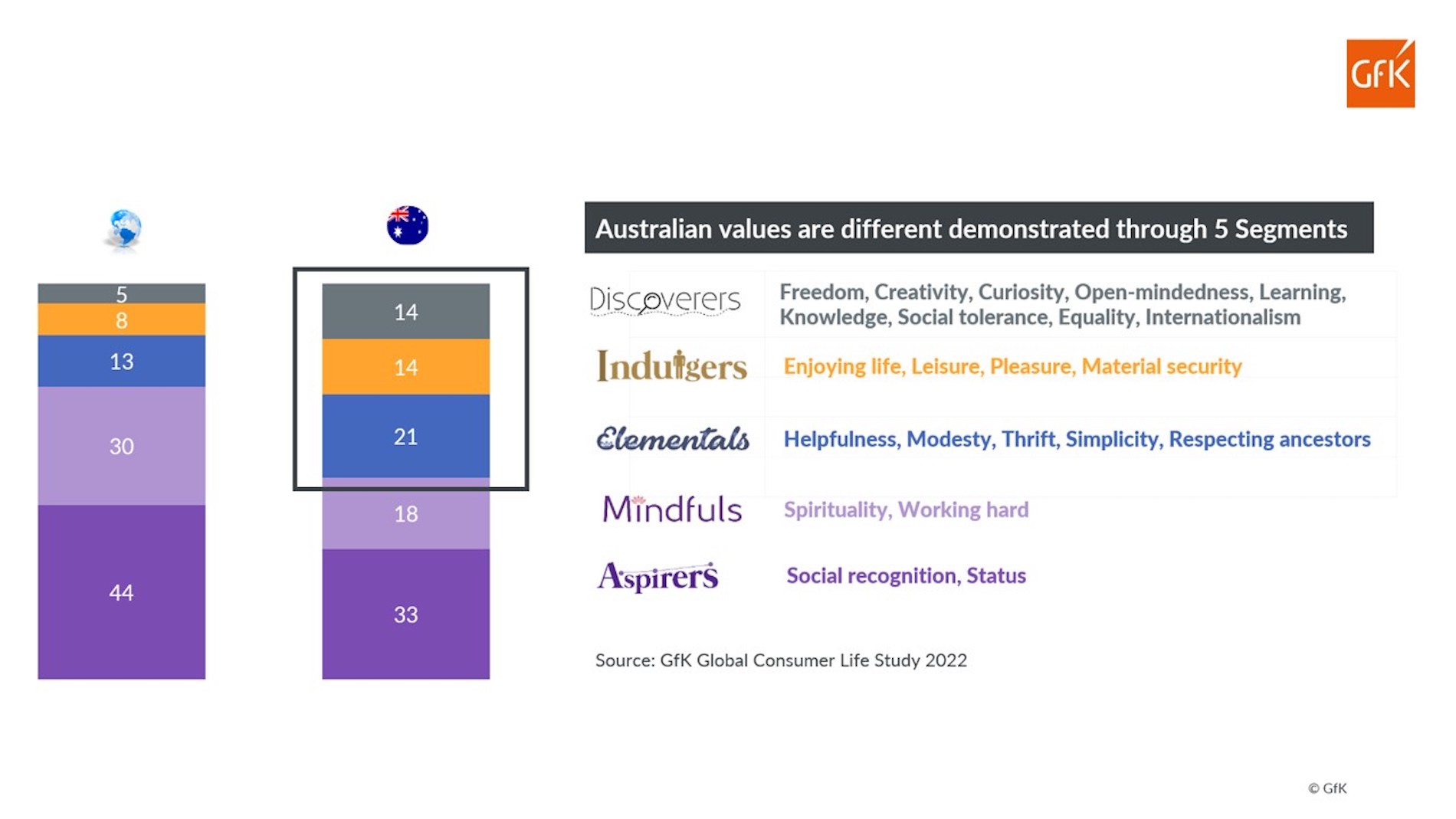GfK reveals latest Australian consumer trends for 2023

There’s no escaping today’s challenges. From skyrocketing inflation, supply chain issues and the lingering pandemic, the business world is in flux. And it can be easy to use the current economic climate as a justification for subpar business performance. However, excuses very rarely (if ever) lead to positive outcomes. That’s why GfK, a global leader in data analytics and consumer behaviour insights, believes now is the time to start finding opportunities.
At its recent GfK’s Insight Forum: Finding Opportunities, Not Excuses, GfK’s head of consumer intelligence and consulting ANZ, Mitesh Khatri, revealed the company’s latest insights into Australian consumer behaviour.
Consumer disrupted: What brands need to know
Values are more than the words up on an organisation’s wall. They’re deep, personal human truths. And these truths should form the guiding principles of every marketing and sales strategy. They can also be the real point of difference in your business. In fact, 62 per cent of consumers say they only buy products and services that appeal to their beliefs, values or ideals.
GfK has been tracking consumer values in 30 markets around the globe for a quarter of a century. Interestingly, it found that Australia’s key values typically differ from the rest of the world. Australians value honesty, protecting family, authenticity, freedom and enjoying life the most. When compared to the globe against five segments (Discoverers, Indulgers, Elementals, Mindfuls and Aspirers), Australians land mostly in the Discoverers, Indulgers and Elementals categories.

Key Values
Discoverers: Freedom, creativity, curiosity, open-mindedness, learning, knowledge, social tolerance, equality, internationalism
Indulgers: Enjoying life, leisure, pleasure, material security
Elementals: Helpfulness, modesty, thrift, simplicity, respecting ancestors
Mindfuls: Spirituality, working hard
Aspirers: Social recognition, status
Says Khatri: “Our research supports the fact that Australians are different. So when we look at global consumers and get global data, it doesn’t necessarily work in this market. Australian consumers love their freedom. They’re pleasure seekers. Material security is important to them. They want to enjoy life. Health and fitness are very important to them. These personal values drive their thinking. And marketers can tap into that opportunity to find better ways to connect with the Australian consumer.
“Brands tend to do well at understanding category predispositions based on consumer needs, attitudes and predispositions of choice. Taking into account these values help marketers understand nuances beyond demographics, geographies, attitudes and needs. And they drive messaging, innovation and brand positioning by enabling marketers to connect with the consumer on a deeper level beyond the surface of what consumers say.”
The opportunity of home
Home has always been the HQ (headquarters) of people’s lives, but increasingly, people are spending even more time at home. According to GfK research, 71 per cent of consumers cook at home for fun, 70 per cent work or study from home and 45 per cent enjoy gardening at home. Others perform home maintenance and repairs (37%) and approximately a quarter (27%) entertain guests in the home.
Interestingly, GfK’s research also finds that Australians are spending more time at home than any other country across the world. In fact, roughly 40 per cent of people are working remotely. It’s a reflection of our labour force, which is largely professional and financial services.
Hybrid environments are driving increases to Australians’ lives at home, particularly around strong premiumisation and indulgence. For example, instead of dining out, more and more people are choosing to cook at home or order from a food delivery service.
In this “new world”, GfK research shows that 44 per cent of consumers say it is important to indulge or pamper themself on a regular basis. This sentiment has led to an increase in purchases across the home in areas like entertainment, health, work, study, cleaning and dining. For example, there’s been a 57 per cent increase in juicer purchases, 184 per cent air fryer purchases and 2,680 per cent increase in Smartphones 5G purchases.
People are looking for convenience, and they’re buying into technology and appliances at home. And it’s not just products. Subscription video on demand is also seeing significant increases as Aussies spend more time at home. At the same time, radio streaming has seen more than a 122 per cent increase.
For brands, GfK research reveals that for higher-spend items like food processors, dishwashers, ovens and fridges, consumers want to be educated and inspired in-store. However, when it comes to smartphones, laptops and fitness wearables, consumers generally go into the store knowing exactly what brand/model they want. The opportunity there is to upsell them on accessories like cases and extended warranties.
Says Khatri: “Marketers can capitalise on category premiumisation — a trend that is driving strong sales value growth. It’s time to invest in the right marketing touchpoints, pre-store versus in-store with core messages of value versus trade-up.”
From data to decisions
In organisations across Australia, data accessibility is a major issue. According to GfK research, only 1 in 4 marketers are very confident in the data systems they use to win and retain customers. Even more, whilst 85 per cent of marketers say direct access to customer data is critical to gain a competitive advantage, only 9 per cent of marketers say customer data is highly accessible.
So what’s holding them back? Three things. The budget to improve martech, systems and processes that connect data silos, and talent to move from data collection to action. GfK research shows that once marketers have data, gathering actionable insights is slow. Only 18 per cent of marketers say they can move quickly from data gathering to actionable insights.
Says Khatri: “This begs the question then, what are those 1 in 4 marketers who are confident in their data systems doing differently? They’re creating a holistic strategy, taking them from macro trends to micro-targeting to niche insights.”
According to GfK’s research, high-performing organisations:
- – Change their mindset on data and what it can do for their business
- – Create an almost frictionless system to access data
- – Access real-time information as the pace of the world requires it
- – Hire the right people and invest in the best tools to create effective engagement plans
Says Khatri: “Data can be a bit of a dirty word. But if you change your mindset on data, you get it in the right place, get support from the top and get the right systems, processes and talent in place; it can be a real game-changer in your business.”
Five questions to ask to power your marketing strategy:
- 1. Present: Against unfavourable macro-economic trends, where are the growth opportunities?
- 2. Future: How do we plan for the future?
- 3. Where: Where should we target and advertise?
- 4. Who: Who should we be targeting and how to reach them?
- 5. How: With so many different data sources, how do we form it into one coherent piece?
Finding opportunities, not excuses
Says Khatri: “In this new world, consumer behaviours are different. Find opportunity in understanding and using values as foundations for your brand strategy to pull apart your industry or category landscape. And when mountains of data leave you feeling overwhelmed, create a roadmap for improvement that balances human intuition with data intellect to drive better business outcomes.”

